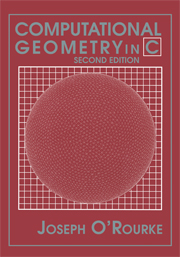3 - Convex Hulls in Two Dimensions
Published online by Cambridge University Press: 05 June 2012
Summary
The most ubiquitous structure in computational geometry is the convex hull (sometimes shortened to just “the hull”). It is useful in its own right and useful as a tool for constructing other structures in a wide variety of circumstances. Finally, it is an austerely beautiful object playing a central role in pure mathematics.
It also represents something of a success story in computational geometry. One of the first papers identifiably in the area of computational geometry concerned the computation of the convex hull, as will be discussed in Section 3.5. Since then there has been an amazing variety of research on hulls, ultimately leading to optimal algorithms for most natural problems. We will necessarily select a small thread through this work for this chapter, partially compensating with a series of exercises on related topics (Section 3.9).
Before plunging into the geometry, we briefly mention a few applications.
Collision avoidance. If the convex hull of a robot avoids collision with obstacles, then so does the robot. Since the computation of paths that avoid collision is much easier with a convex robot than with a nonconvex one, this is often used to plan paths. This will be discussed in Chapter 8 (Section 8.4).
Fitting ranges with a line. Finding a straight line that fits between a collection of data ranges maps to finding the convex region common to a collection of half-planes (O'Rourke 1981).
[…]
- Type
- Chapter
- Information
- Computational Geometry in C , pp. 63 - 100Publisher: Cambridge University PressPrint publication year: 1998
- 1
- Cited by



